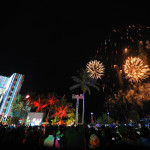In his book The Maldive Mystery, Thor Heyerdahl mentions the discovery of neolithic pottery on Male atoll. The shards were sourced to northwest India where they had been manufactured around 2000 BC or earlier, and many assumed that people from the subcontinent carried the original pots to Maldives.
It is more likely any traders visiting Maldives at that time were Indonesians using an ancient network of sea routes emanating from the Indonesian Spice islands and servicing markets in Africa, Asia and the Americas.
After analysing recent research in the diverse fields of ‘oceanography, traditional histories, physiology, genetics, geology and vulcanology, ship hydrodynamics, global climate history and palaeodemography,’ Charles and Frances Pearce in their book Oceanic Migration claim that seafarers from Halmahera island in Indonesia developed trans-oceanic vessels and navigational and horticultural skills during thousands of years of spice trading. This lucrative business led them to harness major sea currents in the Pacific and Indian Oceans, and to colonise uninhabited islands. They were the ancestors of the Polynesians.
The Pearces assert that these trader-settlers discovered routes to Japan, Hawaii and the Americas by exploring West Pacific Warm Pool sea currents. Halmahera was directly on the equator in an ancient sea between the Sunda and Sahul continents. When the last Ice Age covered much of the northern hemisphere with massive ice sheets and freezing tundra, this area remained warm and fertile, supporting the most diverse plant and animal life on the planet.
Halmahera was not only a centre for the development of spice trade maritime technology and navigational expertise; it was also a hub for migration and the intercontinental transfer of plants, animals and horticultural knowledge, according to the Pearces. Around 5500 BC, when Sunda and Sahul lost their lowlands in a devastating flood, the new geography created by higher seas provided even more demand and opportunities for Halmaheran skills.
Maldives would have looked very different before the flood. The southern equatorial lagoons, shallower than those in the north, had been exposed for tens of thousands of years. Vegetation would have flourished in these sheltered basins and on the surrounding coral ramparts formed during previous high sea level periods. The rocky walls of Maldives must have been visible far out to sea, and equatorial atolls were excellent environments for the cultivation of large coconuts and other plants useful to the Indonesians and their customers.
Twenty thousand years ago during the peak of the last Ice Age, when sea levels were over 120 metres lower, Sri Lanka and India formed a single landmass and Gujarat extended far out to the west. The Persian Gulf was a fertile valley draining down into open lowlands. Dry land linked Africa and Arabia around a long lake in the deepest part of the Red Sea.
Halmaherans must have discovered the westerly route to Maldives and Chagos while following the southern equatorial current flowing from Indonesia to Africa past Madagascar. The current churns both north and south after hitting the African coast. The northern section splits again, offering spice traders the alternative of cruising straight home on the easterly Indian Counter Current, or striking out northwards along the Monsoon Drift to Arabia, the Middle East and eventually India. All these return journeys take them past Maldives.
After an Ice Age of cold winds up to 70 percent stronger than today, and equatorial sea surface temperatures as low as 25 degrees celsius, ocean sailing became more comfortable about ten thousand years ago, according to research cited by the Pearces. Conditions were particularly pleasant from 4000 BC until 1000 BC – a three thousand year period when underwater volcanic activity in Indonesia raised some sea surface temperatures to 35 degrees celsius.
This was ideal for long distance maritime trading and the Indonesians linked with ports supplying expanding markets in Egypt, the Middle East, India and China. Halmaherans were remarkably adapted for long voyages. Their genetic resistance to cold and famine exceeded even that of the Eskimos. The Pearces believe the hardiness of the Halmaherans and their Polynesian descendants was the result of many thousands of years of Ice Age sea travel.
Indonesian spices were readily available in the Middle East by 1721 BC and probably much earlier. Before 1000 BC, seven American plants, including maize, lima bean, phasey bean and Mexican prickle poppy, were introduced to India via routes that often bypassed China. Custard apples and pineapples also appeared in the Middle East no later than the 700-500 BC. At least forty useful American plants had been established in India by 1000 AD.
Halmaheran visits to the Maldivian atolls are a likely source of legends about ancient seafarers called Redin who preceded the Dhivehi speakers. The Redin often returned, appearing from a variety of directions to cruise through the atolls. Sometimes they stayed on an island before sailing off again in fast vessels.
The Pearces suggest that the Halmaherans also helped supply the Old World elite with American drugs such as coca leaves (or a derivative) and tobacco. Tests on nine royal Egyptian mummies, dated from 1070 BC to 395 AD, revealed that all nine had taken coca and cannabis while they were alive, and eight had used tobacco.
Though royalty may have partied on their wares, no powerful kingdom supported the Halmaherans. They survived primarily through their sailing, trading and horticultural skills. When Arab, Indian, Chinese and Malay pirates invaded the Spice Islands in 76 AD and established rival trading stations, the Halmaheran monopoly disappeared.
Before that invasion, spice trading had boomed along land and sea routes between the Roman and Chinese empires. Indonesian adventurers could earn a livelihood by simply riding a raft loaded with cinnamon along the southern equatorial current to Africa. Roman writer Pliny the Elder described their exploits two thousand years ago:
‘They bring their cargo over vast seas on rafts which have no rudders to steer them or oars to push or pull them or sails or other aids to navigation; but instead only the spirit of man and human courage. What is more, they put out to sea in winter, around the time of the northern winter solstice, when the east winds are blowing their hardest. These winds drive them on a straight course… they say that these merchant-sailors take almost five years before they return, and that many perish. In exchange, they carry back with them glassware and bronze ware, clothing, brooches, armlets, and necklaces.’
Cinnamon barges might be useful for one-way deliveries, but Halmaheran outriggers were much faster and capable of sailing almost anywhere. In 2003, Englishman Philip Beale and a team led by Indonesian shipbuilder Saad Abdullah on the Kangean islands north of Bali constructed a nineteen metre double outrigger inspired by 8th century AD relief carvings of Halmaheran vessels on the Borobudur temple. Beale and fourteen crew sailed the bamboo and wood ship, built without nails, from Java to Seychelles in 26 days. From there, they went south around the Cape of Good Hope and up to Ghana.
Cultural and economic change swept over Maldives in the first centuries AD. It transformed a frontier visited by Indonesian traders and subcontinental fishermen into a thriving export economy replete with monarchy, militias, slaves, monks and temples. Sri Lankan shipping and Buddhist business culture were the sources of much of this transformation, and its basic drivers were Bengali and Chinese consumer demand.
All comment pieces are the sole view of the author and do not reflect the editorial policy of Minivan News. If you would like to write an opinion piece, please send proposals to [email protected]





There is a large amount of unfounded and misunderstood speculation here. Why they decided Halmahera was the centre if the shipping merchants universe escapes me. Polynesian DNA shows that they evolved in a very isolated environment - that is their DNA shows two bottlenecks 6000 and 2200 years ago with a marked lack of interbreeding during this time - hardly the DNA profile of prolific sea traders . Thor Heyerdhal had good reason to relate pottery of the Maldives to Northern India - because it was virtually identical in the motif design Check out my Lapita page on my website www.Polynesian-prehistory.com
I think your giving far too much credit to the Indo-poly seafaring and trade network. If you look at the surviving traditional Polynesian sea going vessels they are poor in construction and does not have a trade cargo carrying capacity. The much more modern sea going trade vessels from he region has design would be copied from trade ships that visited those archipelago from the west, ie: south Asia and middle east, some has Chinese designs.
If you look at the Malagasy language, it was a rare dialect spoken even in Indonesia with a considerable Polynesian words and later Sanskrit in them, suggesting that they migrated after the establishment of sri vijaya kingdom in the archipelago.
The Polynesian were no traders they were explorers.
@Peter marsh
That is an interesting read, sadly your hosting plan is limiting.
Maldives needs a museum of civilization (depicting the origin of its people) and a natural history museum that shows the natural history of the flora and fauna of your atolls.
I found it hard it to believe that just today, some idiots smashed a gift by the Pakistani government to the people of Maldives, because it contained images of "idols".
The idiocy of these people escape me completely. Even though the contents of this series is questionable, this does highlight a deep rooted problem within the country.
There's a significant section of the Maldivian population that are a bit like Flatliners. They just don't want to accept reality even when it hits them in their face.
Re: Briko you are correct with regard to the Polynesians - they were not sea traders. The Lapita people were but as DNA proves they were not Polynesian. There has been a lot of misinformation and false connections between the Lapita people and the Polynesians. The Lapita people were most likely sea traders from the western Indian ocean . The rice Padilla rad from Halmahera is the same rat that arrived in NZ 2,200 years ago and then spread northwards into the rest of Polynesia. They were not brought by the Polynesians as such . A lot more research needs to be done to piece together the complex series of migrations that created the Pacific people as we know them today. Migrations from America cannot be ruled out. One thing is for certain Polynesians were not Indonesians. DNA rules that out. Sure they spoke a similar language but that is it. Many people spoke Austronesian from Quechua of Peru to Madagascar. Probably the Sundaland language of the last ice age.
Mr. O'Shea, I always enjoyed your work, enjoy this also.
One question, which I hope yourself or someone can answer. You used the phrase a 'Buddhist business culture,' by that do you mean, selling Buddhist statues and art works or was their a particularly Buddhist way (culture) of doing business? It is the case that some cultures do business differently, so, what is a Buddhist business culture, what is meant here?
Thanks for your information by the way, Michael...